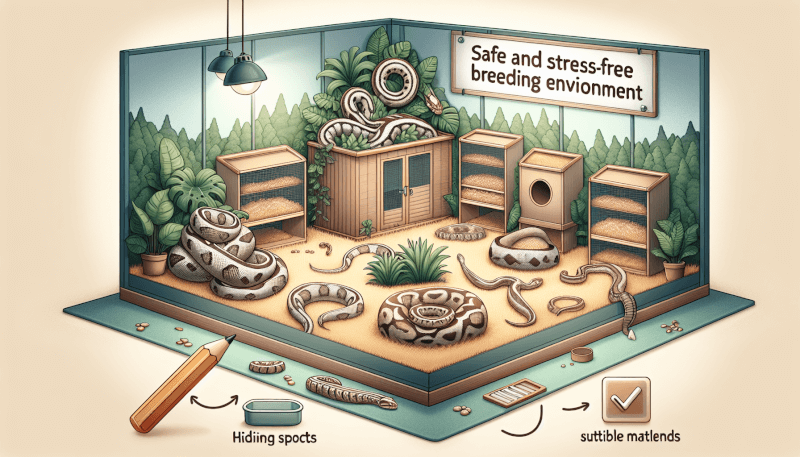If you’re a snake enthusiast looking to breed pet snakes, ensuring a safe and stress-free environment for your reptiles is crucial for their well-being and successful reproduction. Creating the perfect breeding environment involves carefully considering factors like temperature, humidity, and appropriate enclosures. By providing the ideal conditions and minimizing stressors, you can create an environment that promotes healthy breeding and ultimately leads to the growth of your beloved snake family.

Choosing the Right Enclosure
When it comes to creating a safe and comfortable breeding environment for your pet snake, choosing the right enclosure is crucial. Consider the size and species of your snake when selecting the enclosure. Snakes vary in size and habitat requirements, so it’s important to choose an enclosure that will accommodate the specific needs of your snake. Research the typical size and space requirements for your snake’s species to ensure that they have enough room to move and thrive.
Consider the Snake’s Size and Species
Before selecting an enclosure, take into account the size and species of your snake. Different species have different space requirements, so it’s important to choose an enclosure that will allow your snake to move and stretch comfortably. Larger snake species will require larger enclosures, while smaller snakes may be comfortable in more compact habitats. Understanding your snake’s size and species will help you make an informed decision when it comes to choosing the right enclosure.
Select the Optimal Enclosure Size
Once you have considered the size and species of your snake, you can begin to select the optimal enclosure size. It is crucial to provide your snake with an enclosure that is appropriately sized for their needs. A general rule of thumb is to provide an enclosure that is at least as long as the snake’s length, and at least one-third of their length in width. This gives the snake enough space to move, stretch, and explore their environment.
Ensure Proper Ventilation
Proper ventilation is essential in any snake enclosure. The enclosure should have adequate airflow to prevent the buildup of stale air and maintain a healthy environment for the snake. Ensure that the enclosure has proper ventilation through the use of vents or mesh panels. This will help prevent the accumulation of moisture, which can lead to respiratory problems or other health issues for your snake.
Choose the Right Flooring Material
When it comes to the flooring of your snake’s enclosure, it is important to choose the right material. Some popular options include reptile carpet, newspaper, or reptile-safe substrate. Avoid using materials that can be harmful if ingested, such as sand or small substrates that the snake may accidentally swallow. The flooring should be easy to clean and maintain, as cleanliness is crucial for the health and well-being of your snake.
Include Hiding Spots
Snakes are known to be secretive creatures, and they need hiding spots in their enclosure to feel secure. Provide your snake with at least one hiding spot, preferably on both the cool and warm ends of the enclosure. You can use commercial snake hides, or create natural hiding spots using rocks, branches, or other appropriate materials. These hiding spots will allow your snake to retreat and feel safe, reducing stress and promoting a healthy breeding environment.
Maintaining Ideal Temperature and Humidity
Temperature and humidity levels are critical factors to consider when creating a breeding environment for your pet snake. Snakes come from different climates, so it’s essential to research the specific temperature and humidity needs of your snake’s species. Maintaining the ideal temperature and humidity levels will ensure the comfort and well-being of your snake.
Research Temperature and Humidity Needs
Each snake species has its own unique temperature and humidity requirements. It is important to research and understand these needs to create a suitable breeding environment for your snake. Some snakes require higher temperatures, while others prefer cooler environments. Similarly, some snakes need higher humidity levels, while others thrive in drier conditions. By understanding your snake’s specific needs, you can create an environment that mimics their natural habitat.
Install Proper Heating Equipment
Regulating the temperature within the snake enclosure is crucial for their health and well-being. Heating equipment such as heat mats, heat lamps, or ceramic heat emitters can be used to create a suitable temperature gradient. This allows the snake to move between warmer and cooler areas in the enclosure, depending on their preference. Ensure that the heating equipment is safely installed and monitored to avoid any risks of overheating or burns.
Use Thermometers and Hygrometers
To accurately monitor the temperature and humidity levels within the snake enclosure, it is important to use thermometers and hygrometers. Place these devices in different areas of the enclosure to ensure that the ideal conditions are maintained throughout. Regularly check and adjust the temperature and humidity levels as needed to provide your snake with a comfortable and stress-free breeding environment.
Create a Temperature Gradient
Snakes require a temperature gradient within their enclosure to regulate their body temperature effectively. This means providing different temperature zones, including a warm side and a cool side. The warm side should be maintained at the optimal temperature for your snake’s species, while the cool side should be slightly cooler. This temperature gradient allows the snake to move and thermoregulate as needed, promoting overall health and well-being.
Provide a Humid Hide
For snakes that require higher humidity levels, it is important to provide a humid hide within their enclosure. This hide can be created using a container with a hole cut out for entry. Fill the container with damp moss or substrate to create a humid microclimate. The humid hide offers a special retreat where the snake can go to maintain their preferred humidity level and shed their skin more easily.

Ensuring Adequate Lighting
Lighting plays a crucial role in the health and well-being of your pet snake. Proper lighting sources and light cycles help replicate the natural lighting conditions that snakes would experience in their native habitats. Adequate lighting is essential for maintaining a normal day-night cycle, regulating behaviors, and promoting overall health.
Understand the Importance of Light
Light is essential for snakes to maintain a healthy circadian rhythm. It helps regulate their sleep-wake cycle, appetite, and reproductive behaviors. Additionally, UVB light exposure is crucial for the synthesis of vitamin D3, which aids in calcium absorption and prevents metabolic bone disease in snakes. Therefore, choosing the right lighting and replicating natural light conditions is essential for your snake’s overall well-being.
Install Appropriate Lighting Sources
When it comes to lighting sources for your snake enclosure, there are two main options to consider: visible light and UVB light. Visible light is necessary to provide a day-night cycle, while UVB light is required for snakes that are diurnal or require UVB exposure. Consult with a reptile veterinarian or herpetologist to determine if your snake species requires UVB lighting and to select the appropriate bulbs or fixtures.
Set Up Light Cycles
Snakes benefit from having a consistent day-night cycle, similar to their natural habitat. Set up a lighting schedule that provides approximately 12 hours of light and 12 hours of darkness. This will help regulate their internal clock and promote healthy behaviors. Use timers to automate the lighting cycle and ensure consistency. Avoid sudden changes in lighting, as this can cause stress to your snake.
Avoid Excessive Exposure to Light
While providing the right amount of light is important, it is equally important to avoid excessive exposure. Snakes need periods of darkness to rest and feel secure. Avoid leaving lights on 24/7, as this can disrupt their natural sleep-wake cycle and lead to stress or health problems. Strike a balance between providing adequate light and allowing for necessary periods of darkness for your snake.
Establishing a Feeding Routine
Proper nutrition is crucial for the health and well-being of your pet snake. Establishing a feeding routine ensures that your snake receives the necessary nutrients and maintains a healthy weight. Understanding your snake’s dietary requirements, choosing the right prey, and providing a separate feeding enclosure are important factors to consider when it comes to feeding your snake.
Learn the Snake’s Dietary Requirements
Different snake species have different dietary requirements. Some snakes are strict carnivores, while others may require a more varied diet that includes insects or small mammals. Research your snake’s species to determine their specific dietary needs and ensure that you are providing them with the appropriate prey items.
Choose the Right Type and Size of Prey
When selecting prey items for your snake, it is important to choose the right type and size. Prey items should be appropriate for your snake’s size and species. Provide prey items that are roughly the same width as the snake’s body at its widest point. Avoid offering prey items that are too large, as this can lead to regurgitation or other health issues. It is always better to offer smaller prey items more frequently than larger items infrequently.
Offer Food in a Separate Enclosure
To minimize stress and potential injuries, it is recommended to feed your snake in a separate feeding enclosure. This can be a small container or enclosure specifically designated for feeding. By separating feeding from the snake’s main enclosure, you reduce the risk of substrate ingestion, bacterial contamination, or aggression from other snakes if you have multiple enclosures.
Monitor Feeding Behavior
Observe your snake’s feeding behavior to ensure they are actively consuming their prey. It is common for snakes to strike and constrict their prey, so don’t be alarmed by this behavior. Once the snake has consumed the prey item, they may retreat to a hiding spot to digest their meal. Monitor your snake’s feeding behavior and check for any signs of regurgitation, as this could indicate an underlying health issue.

Providing Clean Water and Maintaining Hygiene
Clean water and proper hygiene are vital to the health and well-being of your pet snake. Snakes need access to fresh water at all times to stay hydrated and aid in digestion. Regular water changes and maintaining a clean enclosure are essential for preventing bacterial growth and maintaining a healthy breeding environment.
Place Multiple Water Sources
In order to provide ample drinking opportunities, it is recommended to place multiple water sources within the snake enclosure. Use shallow water dishes that are easy for the snake to access and clean. The availability of multiple water sources will ensure that your snake always has access to fresh water, even if one dish becomes soiled or overturned.
Use Suitable Water Containers
When choosing water containers for your snake, opt for non-porous materials that are easy to clean and sanitize. Avoid using porous materials that can harbor bacteria or promote the growth of algae. Glass or ceramic water dishes are recommended, as they are less likely to tip over or become contaminated.
Change Water Regularly
Fresh, clean water is essential for your snake’s health. Make it a habit to change the water in your snake’s enclosure regularly. Depending on the size of the enclosure and the number of snakes, this may need to be done daily or every few days. Monitoring the water quality and cleanliness will help ensure that your snake has access to a safe and reliable water source.
Keep the Enclosure Clean
Maintaining a clean enclosure is crucial for the health and well-being of your snake. Regularly remove any feces, shed skin, or soiled substrate. Wipe down the enclosure walls and surfaces using a reptile-safe disinfectant. This will help prevent the build-up of bacteria that could lead to infections or disease. Spot cleaning should be performed as needed, and a deep cleaning should be done periodically.
Disinfect the Enclosure Properly
When disinfecting the snake enclosure, it is important to use reptile-safe disinfectants. Avoid using harsh chemicals or cleaners that can be harmful to your snake. Consult with a reptile veterinarian or herpetologist to recommend safe and effective disinfectants. Follow the instructions on the product carefully and ensure that the enclosure is thoroughly rinsed and dried before reintroducing your snake.
Creating a Suitable Substrate
Choosing the right substrate is important for creating a comfortable and safe breeding environment for your pet snake. The substrate must be appropriate for your snake’s species, easy to clean, and free from any potential hazards. Consider the natural habitat of your snake when selecting a suitable substrate.
Consider the Snake’s Natural Habitat
Understanding your snake’s natural habitat is key when selecting a suitable substrate. Some snake species come from arid environments and may require a substrate that helps maintain dry conditions, while others come from more humid habitats and may need a substrate that retains moisture. Research your snake’s natural habitat and choose a substrate that mimics those conditions as closely as possible.
Choose Safe and Easy-to-Clean Substrate
When it comes to substrate, safety and cleanliness are of utmost importance. Avoid using substrates that could be harmful if ingested or cause impaction, such as sand or small particles. Opt for reptile-safe substrates that are easy to spot clean and replace. Newspapers, reptile carpet, or paper towels are popular choices that are safe and easy to maintain.
Avoid Substrates That May Cause Impaction
Some substrates, such as loose substrate or chips, can pose a risk of impaction if ingested by your snake. Avoid using substrates that may cause impaction or intestinal blockages. These can be potentially life-threatening for your snake. As a general rule of thumb, if a substrate can be easily ingested or swallowed, it is best to avoid it.
Provide Proper Substrate Depth
Snakes often engage in burrowing behaviors, so providing a suitable depth of substrate is important. The depth will depend on your snake’s natural habitat and species. Research the typical burrowing depth for your snake and provide enough substrate to allow for this behavior. Too shallow of a substrate may limit your snake’s natural behaviors and increase stress.
Monitor Substrate Conditions
Regularly monitor the condition of the substrate in your snake’s enclosure. Remove any soiled or soiled substrate promptly to maintain cleanliness. Watch out for signs of mold, excessive moisture, or any other issues that may affect your snake’s health. Changing the substrate regularly will help maintain a clean and stress-free breeding environment for your snake.

Managing Environmental Enrichment
Environmental enrichment is an important aspect of creating a stimulating and stress-free breeding environment for your pet snake. Providing a variety of decorative elements, climbing accessories, and environmental stimuli will help keep your snake mentally and physically stimulated.
Add Decorative Elements
Decorative elements such as branches, rocks, or artificial plants can provide a natural and aesthetically pleasing environment for your snake. These elements can also serve as climbing structures or hiding spots. Ensure that any decorative elements are securely placed and do not pose a risk of injury to your snake.
Provide Climbing Accessories
Many snake species are skilled climbers and enjoy having the opportunity to climb in their enclosure. Provide climbing accessories such as branches or logs that are securely anchored to the enclosure. This will allow your snake to engage in natural climbing behaviors, promoting physical exercise and mental stimulation.
Include Branches or Logs
In addition to serving as climbing accessories, branches or logs can also serve as additional hiding spots for your snake. Snakes appreciate having a variety of hiding spots to retreat to when they feel the need for security. By providing multiple options, you create a more enriching and stress-free breeding environment.
Offer Environmental Stimuli
Stimulating your snake’s environment can help prevent boredom and reduce stress. Offer environmental stimuli such as textured objects, scents, or even the presence of non-threatening prey items. These stimuli can mimic elements from their natural habitat and provide mental stimulation.
Handling and Socialization
Handling and socialization are important aspects of owning a pet snake, but they should be done with caution and consideration for the snake’s temperament and comfort. Building trust and acclimating your snake to human interaction will go a long way in creating a positive and stress-free experience for both you and your snake.
Understand the Snake’s Temperament
Each snake has its own unique temperament, and it’s important to understand and respect their individual preferences. Some snakes may be more social and comfortable with handling, while others may be more shy or defensive. Take the time to observe and learn your snake’s behavior, body language, and comfort levels before attempting to handle them.
Acclimate the Snake to Human Interaction
Gradually acclimate your snake to human interaction to ensure a positive experience for both you and the snake. Start by simply observing your snake from outside the enclosure, gradually introducing your presence over time. Once your snake appears comfortable, you can begin to introduce gentle handling, always being mindful of their reaction and comfort level.
Use Proper Handling Techniques
Using proper handling techniques is crucial for the safety and well-being of your snake. Support their body properly and avoid putting excessive pressure or stress on their delicate spine. Avoid sudden movements or actions that could startle the snake. If you are unsure of the proper handling techniques for your snake, seek guidance from a reptile veterinarian or experienced herpetologist.
Limit Handling to Reduce Stress
While handling can be an enjoyable experience for both you and your snake, it is important to limit handling sessions to prevent stress. Snakes are generally solitary and prefer a quiet and calm environment. Excessive handling can cause stress and may lead to defensive behavior or health issues. Find a balance between providing socialization and allowing your snake to have adequate rest and solitude.

Recognizing and Addressing Stress
Stress can have a negative impact on your snake’s health and breeding success. Recognizing signs of stress and taking steps to address them is crucial for creating a safe and stress-free breeding environment for your pet snake.
Identify Signs of Stress
Snakes may exhibit various signs of stress when they are not comfortable in their environment. These signs can include excessive hiding, loss of appetite, frequent attempts to escape, aggressive behavior, or changes in coloration. Familiarize yourself with the typical behavior of your snake’s species and monitor for any unusual or concerning signs that may indicate stress.
Modify the Environment Based on Stress Indicators
If you notice signs of stress in your snake, it may be necessary to modify their environment to alleviate the stressors. Assess the enclosure for potential stressors such as excessive noise, temperature fluctuations, or overcrowding. Make the necessary adjustments to create a calmer and more comfortable environment for your snake.
Avoid Overcrowding
Overcrowding can be a major source of stress for snakes. Ensure that your snake has enough space and is housed appropriately with compatible tankmates, if applicable. If keeping multiple snakes, provide separate enclosures to prevent territorial issues and reduce competition for resources. Overcrowding can lead to increased stress, aggression, and a decline in overall health.
Minimize External Disturbances
Snakes are sensitive to external disturbances, so it’s important to create a peaceful environment for them. Avoid loud noises, sudden movements, or excessive handling that can startle or stress your snake. Place the enclosure in a quiet area of your home, away from high-traffic areas or other pets that may cause unnecessary stress.
Regular Health Check-ups and Veterinary Care
Regular health check-ups and veterinary care are essential for maintaining the health and well-being of your pet snake. Finding a reputable herp veterinarian and scheduling routine check-ups will help catch any potential health issues early and ensure that your snake is receiving the best possible care.
Find a Reputable Herp Veterinarian
Not all veterinarians have experience or expertise in reptile care, so it’s important to find a reputable herp veterinarian for your snake. Research local veterinarians who specialize in reptiles or have experience with snakes. Seek recommendations from fellow reptile owners or reptile-focused online communities to find a veterinarian who can provide high-quality care for your snake.
Schedule Routine Check-ups
Routine check-ups are essential for proactive healthcare and early disease detection. Regularly schedule visits with your herp veterinarian to monitor your snake’s health, discuss any concerns, and receive guidance on husbandry practices. During these check-ups, the veterinarian may perform physical examinations, fecal parasite screenings, and other diagnostic tests, as needed.
Discuss Preventive Measures with the Vet
Preventive measures play a crucial role in maintaining the health of your pet snake. Discuss preventive measures such as vaccination options, parasite control, and habitat hygiene with your herp veterinarian. They can provide guidance on appropriate preventive measures based on your snake’s species, health status, and specific needs.
In conclusion, creating a safe and stress-free breeding environment for your pet snake requires careful consideration and attention to detail. By choosing the right enclosure, maintaining ideal temperature and humidity levels, ensuring adequate lighting, establishing a feeding routine, providing clean water and maintaining hygiene, using suitable substrate, managing environmental enrichment, handling and socializing appropriately, recognizing and addressing stress, and scheduling regular health check-ups, you can create an optimal environment for your snake to thrive. Remember to always prioritize the health and well-being of your pet snake, and consult with a reptile veterinarian or herpetologist for any specific concerns or questions you may have.


